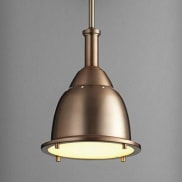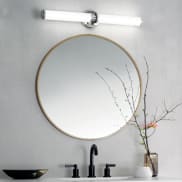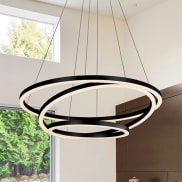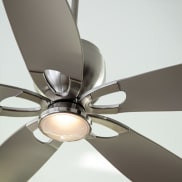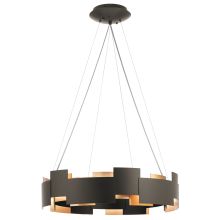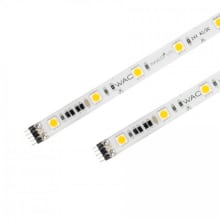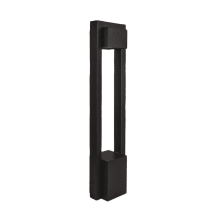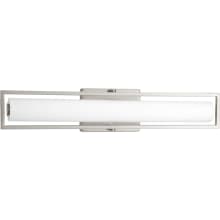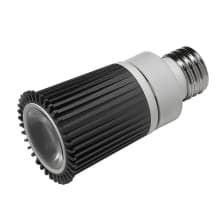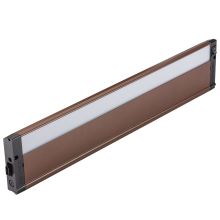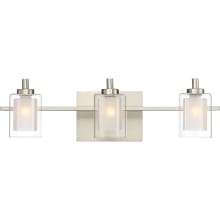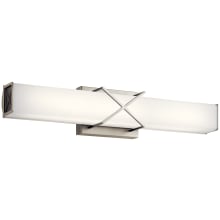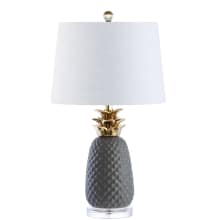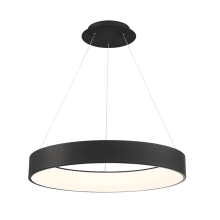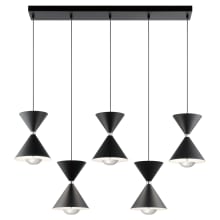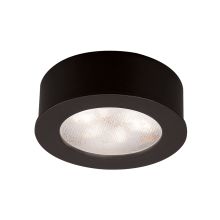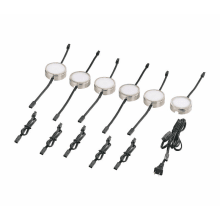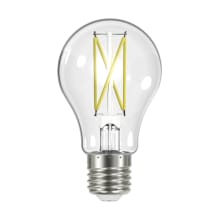OLED vs. LED: The Difference Between Each Lighting Type
Discover the difference between LED and OLED lighting and make the right choice for every fixture throughout your home.
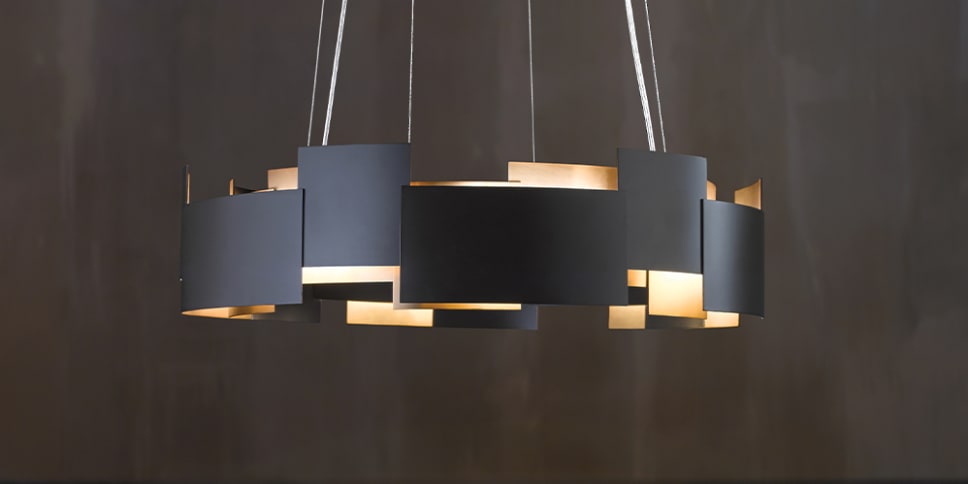
The right lighting solution is essential to every room design. With all the light needed throughout the home, it’s important to choose energy efficient bulbs that provide the brightness you need while minimizing energy usage. You’ve probably already heard of incandescent bulbs, compact fluorescent bulbs (CFLs) and LED light bulbs, but there’s another technology in town — Organic Light-Emitting Diodes (OLED). We’ll break down the difference between LED lighting and OLED lighting so you can make a confident decision about which one is the best choice for the replacement bulbs and new lighting solutions in your home or business.
What is OLED Lighting?
Short for “Organic Light-Emitting Diodes,” OLED lighting is a relatively new technology that has the ability to create dazzling colors with remarkable precision, making them a great option for televisions, monitors, smartphones, and other items that need a digital display.
OLED lighting utilizes a carbon-based organic material to create light-emitting panels. These lights are available in both a bulb and a panel form, many of which are even color-tunable for custom results. The soft look of the light emitted by OLED lights is one of the closest matches to natural light available.
LED and OLED lighting share more than just the name, as both options are environmentally friendly and help to lower energy costs. They also have some very distinct differences that make them each a better fit for various types of projects. Let's take a closer look at the pros and cons for both LED lighting and OLED technology to determine which ones to purchase as replacement bulbs for your fixtures.

OLED Lighting: The Pros & Cons
Before you can decide to use OLED lights in your home or business, you need to know more about the benefits and drawbacks of OLED lights.

Pro: More Environmentally Friendly
While both OLED and LED lights can be Energy Star rated, OLED lights are slightly more environmentally friendly than LED lights. They are entirely made of carbon-based organic materials and ultimately biodegradable. When living sustainably is the focus, OLED lights are an incredibly responsible choice.

Pro: Versatility
Due to the way OLEDs are manufactured, you end up with a flat and flexible panel that can be bent into nearly any shape. This creates endless opportunities for illumination. Oftentimes you’ll find that OLED panels don’t require the use of reflectors or diffusers, which further enhances the design opportunities. This allows it to conform to virtually any custom light fixture.

Pro: Longevity
With an efficiency that ranges from 25 to 50 lumens per watt, it’s currently estimated that OLED lighting will last for 30,000 to 40,000 hours, or roughly 3-5 years of continuous use. Although OLED hasn’t quite caught up to traditional LED lighting in regard to efficiency and lifespan, keep in mind that the technology isn’t yet as advanced. It is possible that the lifespan of the bulb will increase as more OLED lights are developed.

Con: More Expensive
Compared to LED products, this newer “organic” OLED technology is still in the infant stages of development. Because it is relatively new to the game, the organic compounds used to create OLED lighting can be quite expensive. Unfortunately, this means that any fixture or display using this technology will likely have a larger price tag than a comparable LED fixture.

Con: Not as Readily Available
Despite the slightly lower efficiency and higher price point, OLED technology is still gaining in popularity. Currently, you are most likely to find OLED technology in displays, such as smart products, and in portable lights, such as reading lights. OLED lights are also used in custom chandeliers and unique lighting fixtures.
What is LED Lighting?
Light-emitting diodes (LED) are semiconductors that create light when an electrical current passes through to illuminate them. LEDs are not white lights, but are most commonly red, blue, green, or amber. The white light is created by mixing different colors and covering them with phosphor. This technology is offered in traditional bulb form, as well as in light strips that are available in rolls and feature dozens of individual diodes connected to each other. You can use these light strips to add custom illumination underneath cabinetry, inside a piece of furniture, or around an architectural element in your home.

LED Lighting: The Pros & Cons
By far, LED lights are the most common choice for home and office use. A quick look at the pros and cons of this lighting choice will help you determine if they make the best choice for your lighting solutions.

Pro: Longevity
Expect this type of lighting to last much longer, sometimes up to 50,000 hours, which is just under six years of continuous use. Because they produce so little heat, you can even leave them on 24/7 if you need to. Of course, most people won’t keep a light source on continuously, so it’s commonly estimated that LED bulbs may withstand up to 20 years of use in an average household. They have an efficiency of 90-100 lumens per watt, and there is a large assortment of LED light fixtures available to consumers. This makes LED lights ideal for recessed lighting that can be hard to reach when bulbs need replaced.

Pro: Versatility
One of the biggest advantages of LED lighting is that they come in so many different light bulb bases that they are used for everything throughout the home. You can get LED bathroom lighting, LED lamps, LED under cabinet lighting, and everything in between.

Pro: Durability
LED lighting is very durable since it doesn’t have the fragile filaments that traditional lightbulbs do. It can withstand jarring, and some types resist precipitation and humidity, making them a great choice for outdoor light fixtures. However, because it is so durable, LED lights can be very rigid, which means these light sources are not able to be shaped into unique designs.

Con: Color & Brightness Can Change Over Time
As LED lights are used, the color of the light and the brightness can shift or diminish. Near the end of their lifespan, LED lights can be slightly different in both color and brightness from the first day they were used. Fortunately, the change is so slight that it is pretty much unnoticeable.

Choosing Between OLED and LED Lighting
Before you can determine whether LED lighting or LED lights make the best choice for you, it’s important to know what types of lighting your fixture is compatible with. Some light fixtures are OLED compatible while others require LED bulbs. Even within these types of lights, there are different sizes of bulbs, each one with distinct bulb base shapes designed to fit into different types of lighting fixtures. Desk lamps may call for a completely different light bulb shape and size than outdoor flood lights.
LED vs. OLED Lighting: What Does the Future Hold?
Although it is impossible to predict where technology will take us, it is fair to say that a focus on environmentally friendly design will be an integral part of lighting designs for many years to come. Both LED lights and OLED lighting solutions are made to be better for the environment than traditional incandescent light bulbs.
Even though traditional LED lighting is currently the clear leader for efficiency, lifespan, and initial cost, this may not always be the case. When traditional LED bulbs and fixtures first hit the market, they were more expensive and less effective. However, over the years, technological advances have lowered their price point and made them the superior choice for home lighting.
One factor to keep an eye on is how the materials used in the manufacturing of OLED lights change in the coming years. Notably, the cavity glass used for OLED lighting is costly and complex because it is currently made of frit glass. Frit glass is a ceramic composition that’s easier to make and less expensive to use than cavity glass. One expectation is that frit glass will replace cavity glass and, eventually, thin film encapsulation will replace the frit glass, which will lower the cost considerably, but a lot needs to happen for that to take place.
The Verdict
While OLEDs have made their way onto the scene in a major way when it comes to televisions, they have yet to make a big splash in the lighting market. Perhaps one of the primary reasons for this is that LED lights have become so readily available in a vast array of lighting types and sizes and at very inexpensive prices. Not only do OLED lights cost more, but they are also harder to come by.
LED outdoor lighting and indoor lights are available at your local big box stores, making it easy to find replacement bulbs for your existing LED recessed lighting fixtures and stylish lighting solutions around the home.
While OLED lighting is a beautiful option, the price point has made it remain a small niche in a very large industry. Because of the price point and lower demand for the product, the major name brands in lighting have all but dropped out of the OLED market, including GE, Philips, LG, and more. So, for now, LED lighting is likely the ideal choice for most homeowners, simply because it’s more affordable and widely available. This is always subject to change as advancements are made in technology that could eventually lower the cost of making OLED lighting.
However, it’s important to keep in mind that to determine which one is better for you or your project, it really comes down to your unique needs, design preference, and budget.

